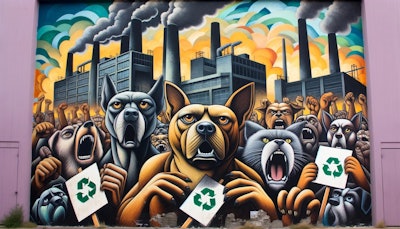How has consumer demand changed in the past few years? What product attributes have become more critical?
Sustainability includes a plethora of concepts and activities, from recycling to fair trade to restoring wetlands. Determining what that term means for a particular pet food company serves as a critical first step in developing a sustainability strategy. Externally, pet owners and industry professionals may not always have the same ideas about what aspects of sustainability matter most. A group of industry experts discussed how a pet food company can keep up with consumers’ changing demands related to sustainability during the Ask the Pet Food Pro panel discussion: Making sustainable pet food at Petfood Forum 2024 in Kansas City, Missouri. Jim Lamancusa, executive director of the Pet Sustainability Coalition, hosted the discussion.
Shannon Landry, Pet Brand Manager, Packaged Facts:
One of the things we do is track trends over time. Our surveys are designed to ask similar questions repeatedly to examine these trends. We have noticed that as older pet owners age out of pet ownership and younger generations take over, there is a distinct change in response levels. Sustainability is one of those significant areas where we have seen a substantial shift. Younger pet owners tend to be more concerned about using sustainable products. They are much more open to sustainable sources, insect protein, and plant-based pet foods. Generally, younger pet owners are more willing to experiment and tend to get their information from each other via social media. Generational differences definitely come into play. With the economic uncertainties happening recently, younger pet owners are hit especially hard. Even those who want to live sustainably and purchase sustainable products may find these products out of their budget. This is something to consider.
Jim Lamancusa, Executive Director of the Pet Sustainability Coalition:
Brian, how have you seen consumer demand changing in the packaging space?
Brian Steinwagner, Executive Vice President with Sustainability Responsibilities, Morris Packaging:
Over the last few years, we have definitely seen a reduction in the size of bags. From 30- or 40-pound bags, we are seeing a shift to the 5- to 15-pound. Additionally, sustainability and sustainable offerings, from recyclable to recycled content, are much more prevalent than they used to be.
Adam Craig, Director of Product Development, Hill’s Pet Nutrition:
I would add that, through some of the insights work we’ve done, there is a growing interest in sustainability, almost a demand and requirement. However, pet parents do not want to compromise health for sustainability. We need to ensure that everything we do reinforces that the nutrition, benefit, and efficacy of the product are still there. I’m optimistic that in some areas we’re exploring, there may actually be an upside where we can deliver both improved nutritional characteristics and sustainability. But at the end of the day, we must be careful not to undermine health and well-being for the sake of sustainability.
Elizabeth Maier, Director, Growth and Innovation, Wilbur-Ellis Nutrition:
I see some discrepancies in this space. Consumers are becoming less tolerant of higher prices but still demand sustainability. Adapting to sustainable practices can be expensive for the industry. This shift has been notable in the past couple of years after COVID. Higher prices were more tolerable before, but now, despite the demand for sustainability, there’s pressure on the industry to manage costs. Additionally, the huge increase in online shopping has a significant sustainability impact, with single deliveries being less efficient. We need to start talking about this more. If we can start these conversations, it will elevate the entire industry.
Stephie Volo, Chief Impact Officer, Earth Animal:
I think everyone is right on point. One thing that’s really important, as Shannon mentioned, is data. Business intelligence is incredibly important, and so is knowing where we get our information. We’re fortunate to have discussions about it. It is generational, but also, pet parents who care most about sustainability are clear about their priorities. They care about the climate, their animals, and quality nutrition. They are more vocal than ever. They stay informed about regulations, which will help us in the industry to collaborate and meet those regulations. We rely on data and research to market effectively. However, understanding your audience’s expectations is challenging because there is often a discrepancy in data, and what people say may not be what they mean. There are numerous opportunities for the industry. Everyone loves their pets and wants to provide high-quality, nutritious products with minimal social or environmental impact. Through the PSC, we are helping brands work closely with suppliers to adopt holistic practices, ensuring meaningful storytelling about these efforts resonates with their audience and meets expectations. Created by Tim Wall using DALL-E 3
Created by Tim Wall using DALL-E 3
